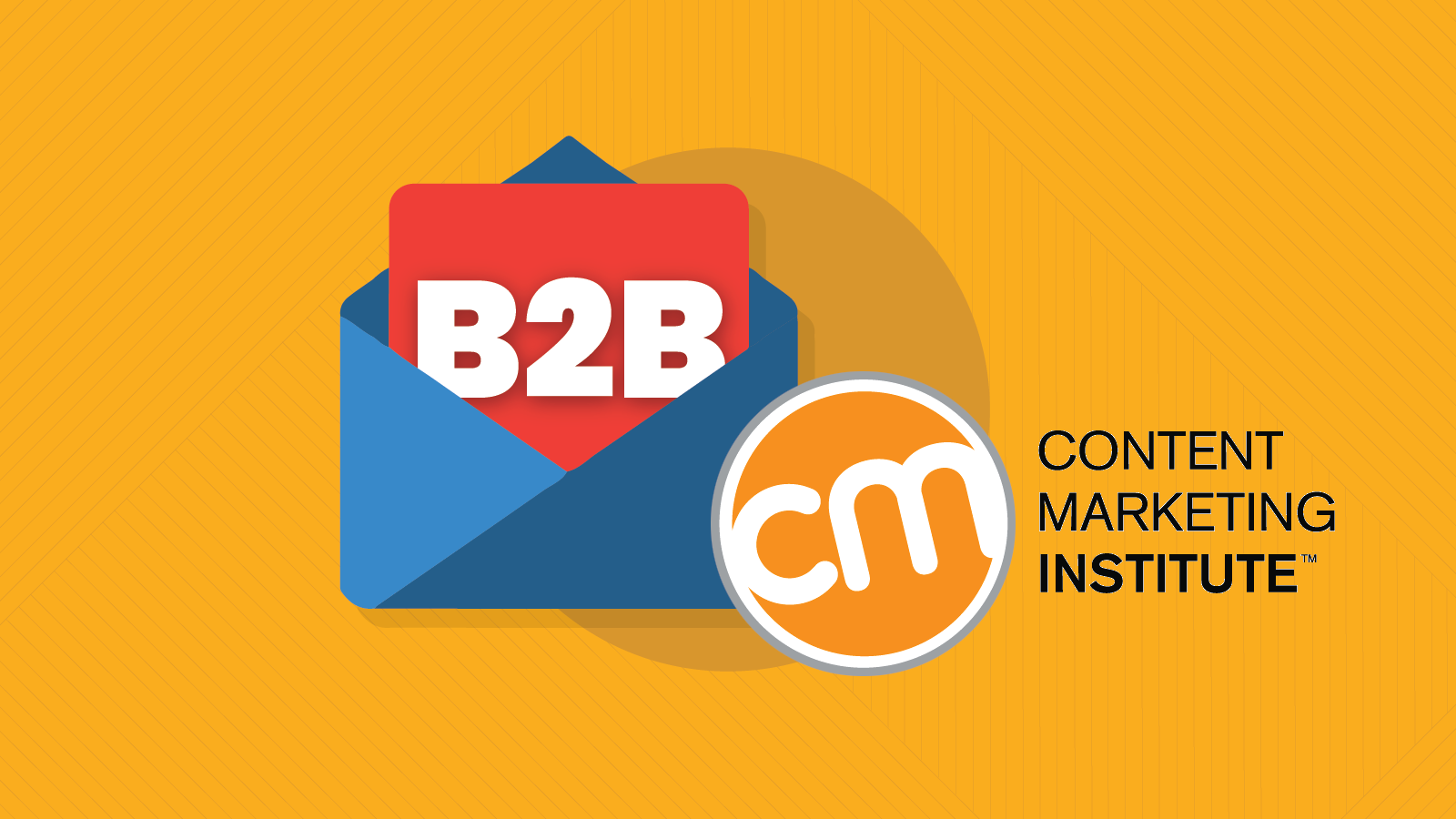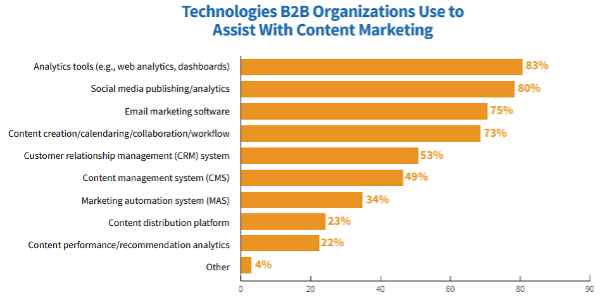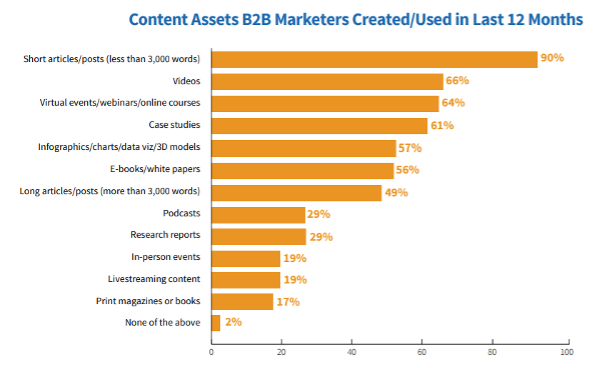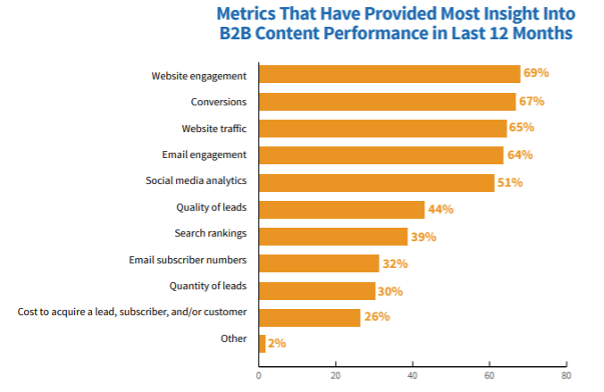Email Marketing
Email and B2B Content Marketing in 2022

Email Marketing

If I was prone to using clichés in my blog posts, I might be tempted to suggest that email and content marketing go together like peanut butter and jelly. But in the more grown-up world of B2B marketing, I prefer to think of these complementary marketing channels as rum and coke (insert your beverage of choice). As a combined marketing strategy, they create something that is easy to consume — but comes with a real kick.
Email and B2B content help marketers do precisely what they are paid to do — position the right message in front of the right person at the right time. Add social media into the mix, and you’ve got a solid foundation to build your entire marketing strategy on which I call the “holy trinity of content marketing.”
But don’t just take my word for it. The Content Marketing Institute (CMI) recently published its 12th annual B2B Content Marketing Benchmarks, Budgets, and Trends report for 2022, which highlights the benefits of combining the efforts of your organization’s email and content marketing teams to maximize engagement.
So, let’s take a deep dive into the CMI report to understand how leading B2B email marketing and content marketing organizations are working together to achieve their objectives.
According to the report, 75% of B2B marketers use email marketing software to assist with their content marketing efforts.

We believe the reason for this is simple. Without including email marketing in the mix, your content marketing efforts might never reach their intended audience.
While content marketers invest considerable time and effort into creating content optimized for the major search engines, there is absolutely no guarantee that content will rank well against their competitors or even be found. While search engine optimization (SEO) is a much-needed skill, it is also something of a dark art and inexact science.
Social media also offers a bleak picture for many content marketers. The various social media network algorithms, keen to push paid promotion, may mean that very few followers are presented with their content organically.
For example, the average organic reach on Facebook is only 5.2%. This means that unless you are paying for the privilege of engaging your followers, nearly 95% of them will never see each post.
Meanwhile, the average lifespan of a tweet is 18 minutes. So even if you are publishing three or four tweets a day, you will not be seen by the vast majority of your followers.
Posts to LinkedIn, the B2B marketers’ favorite social media channel, have a much longer 48-hour shelf life. But when you consider only 22% of users access the professional network on a daily basis, it’s easy to see why your content gets left on the shelf.
Email is the only marketing technology that guarantees delivery into an environment checked multiple times a day. The average person checks their email upwards of 15 times per day.
Email marketers can also tailor their campaigns to individual subscribers’ needs — meaning that content is only sent to people who opted-in and have expressed a preference to see a particular type of content. That’s right — your email marketing subscribers actually appreciate and really want to read your content.
Content distributed by email is typically perceived by its recipients as “owned content.” This means it comes from an organic and trusted source and is generally better received than “earned content,” which is typically distributed via a third party.
The success of owned content is again based on the solid relationship marketers have with their opt-in subscribers. This empowers marketers to become publishers and bypass traditional media partners effectively. As a result, marketers don’t have to co-exist in the same marketing landscape as their competitors by distributing owned content. It also means they don’t have to fight to be heard above all the other “marketing noise” served by online publishers or risk being blocked by ad-blockers.
According to the CMI report, the most popular content marketing assets for B2B marketers include virtual events and online training programs, research reports, short articles (less than 3,000 words), and eBooks and Whitepapers.

When considering the significant investment required to produce many of these content marketing assets, it would seem illogical not to consider email marketing to distribute and amplify that content.
Email and content marketing success can only be truly understood if you set objectives and analyze your results. Therefore, it should be no surprise that 75% of B2B marketing organizations closely measure their content marketing metrics.
Email marketing engagement is a priority metric for many content marketers, with 64% believing it provides valuable insight into the success of their campaigns. Only website engagement, conversions, and website traffic are more highly valued — and it’s easy to see how all four metrics are connected.

The CMI report suggests that 32% of marketers look towards subscriptions to measure content marketing success. Email subscribers are another great metric to follow to gauge your content marketing success. As a simple rule of thumb, if your email subscribers are rising, your content is hitting the mark. Conversely, if your subscribers are in decline, you may need to optimize your content to meet their expectations.
The real question I would have to ask is to the 25% of marketers who are either not measuring their content’s performance or don’t know if it’s being measured. How can they ever know if their activities are successful or not? Even if their campaigns are being seen, generating traffic, and converting into sales, how do they know if they could be doing so much better?
The potential for waste here is staggering. If you are currently not measuring your marketing activities — I suggest you stop what you are doing until you can.
As with any marketing strategy, understanding your email marketing metrics and optimizing using a consistent approach to testing, measuring opens, click-through rates, and unsubscribes is vital to maximizing your success.

Don’t miss the Ultimate Guide to B2B Email Marketing from our colleagues at Sinch Mailjet.
When email is so important to your content marketing team, they must have access to the right technology in their Martech stack to work smarter.
Email on Acid is part of the Pathwire family, a one-stop-shop for all the email marketing technology any content marketing team needs. This includes Mailjet, an email marketing service provider (ESP) offering a robust and easy-to-use WYSWYG email design-builder, and Mailgun, a powerful API solution for transactional emails and deliverability services.
Because email marketing is vital to your content marketing campaign’s success, you don’t want it to be the weakest link. This is where Email on Acid comes in.
Email on Acid’s pre-deployment technology ensures that your emails arrive in the inbox as intended regardless of how they are viewed. In addition, the service checks hundreds of different email clients and devices for compatibility issues and scans email content for embarrassing spelling and grammatical errors, bad image links, and catastrophically broken links.
If your B2B audience is thirsty for more great, insightful content, adding a dash of email marketing will make it go a long way.
Book a demo here for more information about how Email on Acid can help your content reach a wider audience.